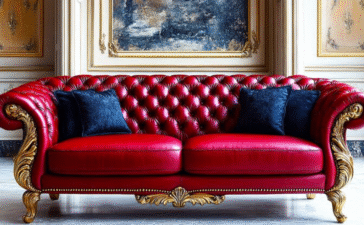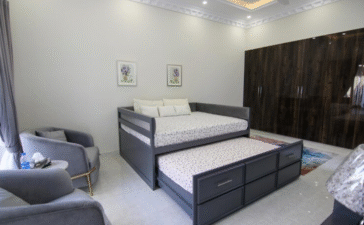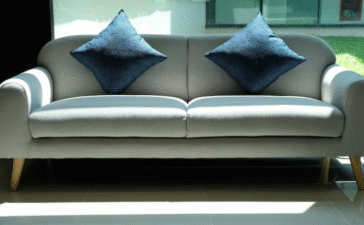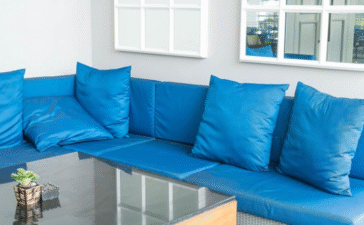The traditional sofa stands as one of the most enduring and beloved pieces of furniture in home design. Unlike fleeting trends that come and go, these classic seating pieces have maintained their appeal for centuries, gracing living rooms with sophisticated charm and unmatched comfort. From the stately homes of Victorian England to contemporary urban apartments, traditional sofas continue to anchor living spaces with their distinctive elegance and robust construction.
What makes the traditional sofa such a compelling choice for homeowners? The answer lies in their unique ability to blend historical craftsmanship with practical functionality. These pieces represent more than mere furniture; they embody a design philosophy that prioritizes quality materials, meticulous construction, and timeless aesthetic appeal. Whether you’re furnishing a formal living room or creating a cozy family gathering space, understanding the nuances of traditional sofa design can help you make an informed investment that will serve your home for decades.
The appeal of classic sofas extends beyond their visual impact. Research conducted by furniture industry analysts indicates that well-constructed traditional sofas retain. Their structural integrity and comfort for 15-20 years on average, significantly longer than many contemporary alternatives. This longevity, combined with their versatile styling potential, makes traditional sofas a smart choice for homeowners seeking both beauty and value.
What Defines a Traditional Sofa?
Traditional sofa design encompasses specific architectural elements that have been refined over generations of furniture making. These distinctive features create the classic silhouette that immediately identifies a piece as traditionally styled, setting it apart from modern or contemporary alternatives.
Rolled arms represent perhaps the most recognizable feature of traditional sofa design. These curved armrests, often padded and upholstered, provide both comfort and visual softness that contrasts beautifully with the sofa’s structured frame. The rolling technique used to create these arms requires skilled craftsmanship. As the upholsterer must carefully shape the padding and fabric to achieve the smooth, rounded appearance.
Tufted backrests add another layer of sophistication to traditional sofas. This technique involves pulling buttons or fabric through the cushioning to create distinctive dimpled patterns. Deep button tufting, popularized during the Victorian era, remains a hallmark of traditional sofa construction. The process requires precision and expertise, as each tuft must be placed symmetrically and secured properly to maintain both appearance and structural integrity over time.
Wood frame construction forms the foundation of authentic traditional sofas. Master craftsmen typically use hardwoods such as oak, mahogany, or maple to create frames that can withstand decades of use. These wooden frameworks often feature decorative elements including carved details, turned legs, and ornamental flourishes that reflect the furniture styles of specific historical periods.
The historical evolution of traditional sofa design spans several centuries, beginning with the formal settees of the 17th century. These early pieces evolved through various style periods, including Georgian, Victorian, and Edwardian eras, each contributing unique design elements that continue to influence contemporary traditional sofa construction. Understanding this heritage helps explain why certain proportions, decorative details, and construction methods persist in modern traditional sofa manufacturing.
Material Choices for Traditional Sofas
The selection of materials significantly impacts both the appearance and performance of traditional sofas. Quality materials not only enhance the sofa’s visual appeal but also contribute to its durability and long-term value.
Wood frame construction remains the gold standard for traditional sofas. Hardwoods like mahogany offer exceptional strength and beautiful grain patterns that complement the sofa’s classic styling. Oak provides outstanding durability with its dense grain structure, making it ideal for frames that must support years of regular use. Maple, prized for its fine grain and light color, works particularly well when stained to match specific décor schemes.
The kiln-drying process used in quality wood frame preparation reduces moisture content to optimal levels, preventing warping, cracking, or joint separation over time. Premium manufacturers often reinforce critical stress points with additional bracing and use traditional joinery techniques such as mortise-and-tenon connections rather than relying solely on screws or staples.
Upholstery choices for traditional sofas divide primarily between leather and fabric options, each offering distinct advantages. Top-grain leather develops a beautiful patina with age and provides natural durability that can withstand decades of use. Full-aniline leather, while more expensive, offers the softest hand feel and most natural appearance, though it requires more careful maintenance than semi-aniline alternatives.
Fabric upholstery opens up extensive possibilities for color, pattern, and texture. Traditional favorites include rich velvets that add luxurious depth to formal settings, classic tweeds. That provide durability with understated elegance, and fine linens that offer breathability and casual sophistication. The weight and weave of the fabric directly impact both appearance and longevity, with heavier fabrics generally providing better wear resistance.
Professional-grade upholstery fabrics undergo rigorous testing for factors like abrasion resistance, colorfastness, and pilling tendency. The Martindale test, widely used in the furniture industry, measures fabric durability by simulating wear patterns. Fabrics rated for 25,000 Martindale cycles or higher typically provide excellent longevity for residential use.
Why Choose a Traditional Sofa for Your Living Room?
Traditional sofas offer compelling advantages that extend far beyond their classic appearance. These benefits make them particularly attractive to homeowners seeking furniture that combines aesthetic appeal with practical functionality.
Elegance and timeless appeal represent the primary draw for most traditional sofa buyers. Unlike trendy pieces that may look dated within a few years, traditional sofas maintain their sophisticated appearance across changing décor styles. This versatility allows homeowners to update. Their living spaces through accessories, paint colors, and complementary furniture while keeping their sofa as a constant anchor piece.
The design flexibility of traditional sofas enables them to work effectively in various interior styles. A well-chosen traditional sofa can enhance a formal traditional room, provide grounding contrast in a contemporary space, or add sophisticated polish to an eclectic mix of furniture styles. This adaptability makes traditional sofas particularly valuable for homeowners who enjoy evolving their décor over time.
Comfort considerations play a crucial role in traditional sofa appeal. The substantial construction typical of these pieces, including generous cushioning and proper ergonomic proportions, creates seating that supports extended periods of relaxation. Unlike some modern designs that prioritize visual impact over comfort, traditional sofas emphasize the balance between attractive appearance and practical usability.
Durability represents another significant advantage of quality traditional sofas. Construction methods developed over centuries of furniture making emphasize longevity through solid wood frames, quality joinery, and premium materials. When properly maintained, a well-made traditional sofa can provide comfortable seating for 15-20 years or more, making it a cost-effective investment compared to less expensive alternatives that require frequent replacement.
The resale value of traditional sofas typically exceeds that of contemporary pieces, particularly when the original construction quality was high. Antique and vintage traditional sofas often appreciate in value, while well-maintained contemporary traditional pieces retain more of their original purchase price than modern alternatives.
The Different Styles of Traditional Sofas
Understanding the various traditional sofa styles helps homeowners select pieces that best complement their space and personal preferences. Each style carries distinct characteristics that reflect different historical periods and design philosophies.
The Chesterfield sofa stands as perhaps the most iconic traditional style. Originally created in the 18th century, Chesterfields feature deep button tufting across. The back and arms, creating a distinctive quilted appearance. The rolled arms sit at the same height as the back, creating a continuous line that emphasizes the sofa’s formal character. Traditional Chesterfields used leather upholstery, though contemporary versions often feature fabric alternatives while maintaining the characteristic tufting pattern.
Authentic Chesterfield construction requires considerable skill, as the tufting process must be executed precisely to create uniform button placement and consistent fabric tension. The deep tufting not only provides visual interest but also helps maintain the shape and support of the cushioning over time.
Tuxedo sofas represent a more streamlined approach to traditional design. These pieces feature straight, unrolled arms that align with the back height, creating clean lines that work well in both formal and casual settings. The simplified silhouette makes tuxedo sofas particularly versatile, allowing them to integrate effectively with various décor styles while maintaining their traditional character.
The upholstery treatment of tuxedo sofas often emphasizes luxurious fabrics like silk, velvet, or fine wool blends. The straight lines of the design showcase fabric patterns effectively, making tuxedo sofas excellent choices for featuring decorative textiles.
English roll arm sofas offer a more relaxed interpretation of traditional design. The arms feature a distinctive outward roll that creates visual softness and provides comfortable arm support for lounging. This style often incorporates loose back cushions rather than the fixed backs common in more formal traditional styles, enhancing comfort while maintaining classic proportions.
The curved lines of English roll arms require careful upholstery work to achieve the proper shape and maintain it over time. Quality construction includes internal support structures that prevent the arms from losing their rolled profile with regular use.
Cabriole sofas distinguish themselves through elegant curved legs that reflect French design influences from the 18th century. These graceful legs, often carved with decorative details, elevate the sofa both literally and figuratively, creating an impression of refined sophistication. The curved leg design requires skilled woodworking to achieve proper proportions and structural integrity.
Upholstered seats and backs on cabriole sofas typically feature more tailored construction than other traditional styles, with precise welting and careful attention to fabric placement that highlights the sofa’s elegant lines.
How to Style a Traditional Sofa in Your Home
Successfully incorporating a traditional sofa into your living space requires thoughtful consideration of layout, complementary furnishings, and decorative elements that enhance rather than compete with the sofa’s classic appeal.
Living room arrangements should position traditional sofas to maximize both their visual impact and functional utility. In larger rooms, placing the sofa as the focal point facing the main traffic pattern creates an inviting conversation area. Flanking the sofa with matching side tables or complementary armchairs establishes a balanced, symmetrical arrangement that enhances the sofa’s formal character.
For smaller spaces, positioning a traditional sofa against the longest wall maximizes seating while maintaining adequate traffic flow. Adding a coffee table at an appropriate distance (typically 14-16 inches from the sofa’s edge) provides functional surface space while maintaining proper proportions in the room layout.
Complementary accessories play a crucial role in highlighting traditional sofa design elements. Decorative pillows should complement rather than overwhelm the sofa’s lines and upholstery. For leather sofas, pillows in contrasting textures like silk, velvet, or fine wool add visual and tactile interest. Fabric sofas benefit from pillows that either coordinate with the main upholstery or provide controlled contrast through pattern or color variation.
Throw blankets serve both functional and aesthetic purposes, adding warmth and texture while providing an easy way to introduce seasonal color changes. Cashmere, wool, or high-quality cotton throws drape beautifully over traditional sofa arms and add inviting comfort to the seating arrangement.
Area rugs help define the seating area and provide visual grounding for traditional sofas. The rug should be large enough to accommodate at least the front legs of the sofa and any accompanying coffee table. Traditional patterns like Persian or Oriental designs complement classic sofa styles. While solid colors or subtle textures can provide neutral backgrounds that emphasize the sofa’s design details.
Blending traditional sofas with modern elements creates dynamic, personally expressive interiors. That avoid the museum-like quality sometimes associated with purely traditional rooms. Contemporary art, modern lighting fixtures, or sleek accent tables can provide interesting contrast while respecting the sofa’s classic character. The key lies in maintaining balance between traditional and modern elements rather than allowing either style to dominate completely.
Customizing Your Traditional Sofa
Custom traditional sofas offer the opportunity to create seating perfectly tailored to your space requirements and design preferences. This personalization ensures optimal fit, comfort, and aesthetic integration with your existing décor.
Dimensional customization addresses the practical challenges of fitting furniture into specific spaces. Standard sofa lengths may not work effectively in rooms with architectural features like built-in bookcases, fireplaces, or unusual wall configurations. Custom manufacturers can adjust length, depth, and height to optimize the sofa’s fit while maintaining proper proportions and comfort.
Seat depth customization proves particularly valuable for households with varying height requirements. Deeper seats accommodate taller individuals more comfortably, while shallower depths work better for shorter family members. Custom makers can also adjust seat height to complement existing furniture or accommodate specific comfort preferences.
Upholstery customization extends far beyond simple color selection. Custom options include fabric grade selections that balance cost with durability requirements, pattern matching for large-scale designs, and contrast welting or trim details that enhance the sofa’s design elements. Some manufacturers offer custom fabric programs that allow customers to supply their own materials for truly unique results.
Hardware and finish customization includes options for leg styles, decorative nail head trim, and wood stain selections that coordinate with existing furniture. These details may seem minor but significantly impact the final appearance and integration of the sofa within the room’s overall design scheme.
Selecting a reputable custom sofa maker requires research into their construction methods, material sourcing, and customer service practices. Quality custom manufacturers typically offer detailed information about their frame construction, spring systems, and cushion materials. They should also provide clear timelines for completion and comprehensive warranty coverage that reflects confidence in their craftsmanship.
Customer reviews and references provide valuable insights into the manufacturer’s reliability and product quality. Established custom furniture makers often maintain showrooms or galleries where potential customers can examine construction details and material options firsthand.
Where to Buy Traditional Sofas
The traditional sofa market offers various purchasing channels, each with distinct advantages and considerations that affect both the buying experience and final product satisfaction.
Online furniture retailers provide extensive selection and competitive pricing, often featuring detailed product descriptions, multiple viewing angles, and customer reviews that help inform purchase decisions. The convenience of shopping from home appeals to many buyers, particularly when combined with generous return policies and white-glove delivery services.
However, online shopping limitations include the inability to test comfort levels, assess construction quality, or examine material samples before purchase. Color representation can vary significantly between computer screens and actual fabrics, potentially leading to disappointment when the sofa arrives.
Physical showrooms and furniture stores allow hands-on evaluation of comfort, construction quality, and material characteristics. Experienced sales staff can provide valuable guidance about different brands, construction methods, and care requirements. Many furniture stores also offer design consultation services that help customers select sofas that complement their existing décor.
The main drawbacks of showroom shopping include limited inventory selection compared to online retailers and potentially higher prices due to overhead costs. However, the ability to sit on the sofa, feel the upholstery materials, and examine construction details often justifies the additional effort required for in-person shopping.
When evaluating traditional sofas for purchase, key factors include frame construction quality, cushion composition and density, upholstery material grade, and manufacturer warranty coverage. Solid wood frames with proper joint reinforcement indicate quality construction. While cushion cores using high-resilience foam or down-blend fills provide better long-term comfort than low-density alternatives.
Return policies deserve careful attention, particularly for online purchases. Quality furniture retailers typically offer 30-90 day return periods, though custom orders may have different terms. Understanding the return process, including who pays return shipping costs and any restocking fees, helps avoid unpleasant surprises if the sofa doesn’t meet expectations.
Several manufacturers have established strong reputations for traditional sofa construction. Companies like Henredon, Baker Furniture, and Lee Industries are known for quality craftsmanship and durable construction. Mid-range manufacturers such as Flexsteel and La-Z-Boy offer good construction quality at more accessible price points.
Maintenance and Care for Your Traditional Sofa
Proper maintenance significantly extends traditional sofa lifespan while preserving appearance and comfort. Different upholstery materials require specific care approaches to maintain their beauty and durability.
Leather upholstery maintenance begins with regular dusting using a soft, dry cloth to remove surface debris that can cause scratching over time. Monthly conditioning with high-quality leather conditioner helps maintain the material’s suppleness and prevents cracking or drying. The conditioning frequency may need adjustment based on room humidity levels and usage patterns.
Spill cleanup on leather requires immediate attention to prevent staining or permanent damage. Blotting rather than wiping prevents the liquid from spreading, while avoiding harsh cleaning chemicals preserves the leather’s natural characteristics. Professional leather cleaning services can address more serious stains or overall refreshing needs.
Fabric upholstery care varies considerably based on the specific material and its care requirements. Regular vacuuming with appropriate attachments removes dust and debris that can cause fabric deterioration over time. Rotating cushions helps distribute wear patterns evenly, extending the upholstery’s attractive appearance.
Professional fabric cleaning typically proves more effective than do-it-yourself methods, particularly for expensive or delicate materials. Many furniture retailers can recommend cleaning services that specialize in high-quality upholstery fabrics and understand the specific requirements of different fiber types.
Wood frame care focuses on preventing damage from moisture, temperature extremes, and physical impact. Regular dusting with appropriate furniture polish maintains wood luster while providing protection against minor scratches and water marks. Avoiding placement near heat sources, air conditioning vents, or areas with high humidity helps prevent wood expansion, contraction, or warping.
Periodic inspection of frame joints, particularly in high-stress areas, allows early detection of loosening or damage that might require professional attention. Quality traditional sofas should maintain structural integrity for many years. But prompt attention to minor issues prevents more serious problems from developing.
Traditional Sofas as Investment Pieces
Understanding traditional sofas as investment furniture helps justify the higher initial cost while emphasizing the long-term value these pieces provide to homeowners. Unlike disposable furniture designed for short-term use, quality traditional sofas represent substantial investments that can appreciate over time.
The initial investment in a quality traditional sofa typically ranges from $2,000 to $8,000 or more, depending on size, materials, and construction quality. This substantial upfront cost often causes sticker shock compared to mass-market alternatives priced under $1,000. However, analyzing the cost per year of use reveals the true value proposition.
A quality traditional sofa lasting 20 years at a $4,000 purchase price costs $200 annually. While a $800 alternative replaced every 5 years costs $160 annually plus the inconvenience of repeated shopping and disposal. The higher-quality piece also provides superior comfort and aesthetic appeal throughout its service life.
Resale value considerations become particularly relevant for homeowners who relocate frequently or enjoy changing their décor regularly. Quality traditional sofas retain significant value in secondary markets, particularly if they feature desirable materials like leather upholstery or represent recognized manufacturer brands.
Antique traditional sofas often appreciate substantially over time, making them attractive to collectors and investors. Even contemporary traditional pieces from quality manufacturers tend to hold their value better than modern alternatives, providing some financial protection against the investment.
The environmental impact of furniture choices increasingly influences consumer decisions. Quality traditional sofas contribute to sustainability through their longevity, reducing the environmental costs associated with frequent furniture replacement and disposal. Many traditional sofa manufacturers also emphasize sustainable material sourcing and responsible manufacturing practices.
Frequently Asked Questions
What makes a sofa “traditional” versus contemporary or modern?
Traditional sofas feature specific design elements that reflect historical furniture styles, including rolled arms, tufted backs, decorative wood frames, and classic proportions. Contemporary and modern sofas emphasize clean lines, minimal ornamentation, and often incorporate materials like metal or glass that are uncommon in traditional pieces.
How long should I expect a quality traditional sofa to last?
Well-constructed traditional sofas with solid wood frames and quality upholstery typically provide 15-20 years of comfortable use with proper maintenance. Premium pieces from established manufacturers can last significantly longer, with some antique traditional sofas remaining functional and attractive for over a century.
Is leather or fabric upholstery better for traditional sofas?
Both materials offer advantages depending on your priorities. Leather provides exceptional durability, develops attractive patina over time, and handles spills better than most fabrics. Fabric upholstery offers greater variety in colors and patterns, generally costs less than leather, and may feel more comfortable in extreme temperatures.
How do I determine the right size traditional sofa for my living room?
Measure your space carefully, allowing for adequate traffic flow around the sofa. A general rule suggests leaving at least 30 inches of walking space behind the sofa and 14-16 inches between the sofa and coffee table. Consider the room’s proportions as well, avoiding sofas that overwhelm smaller spaces or appear lost in larger rooms.
Can traditional sofas work in modern or contemporary room designs?
Absolutely. Traditional sofas can provide elegant contrast in contemporary settings, adding warmth and visual interest to minimalist spaces. The key lies in balancing the traditional sofa with modern accessories, lighting, and complementary furniture to create a cohesive, sophisticated look.
What’s the difference between a Chesterfield and other traditional sofa styles?
Chesterfields feature distinctive deep button tufting across the back and arms, with rolled arms that sit at the same height as the back. Other traditional styles like English roll arms or tuxedo sofas have different arm treatments and may lack the characteristic tufting pattern.
How much should I budget for a quality traditional sofa?
Quality traditional sofas typically range from $2,000 to $8,000, with custom pieces potentially costing more. While this represents a significant investment, the longevity and enduring style of these pieces often make them cost-effective compared to frequently replaced lower-priced alternatives.
Do traditional sofas require professional cleaning?
Professional cleaning is recommended for both leather and fabric traditional sofas to maintain their appearance and extend their lifespan. Leather sofas may need professional conditioning every few years. While fabric sofas benefit from professional deep cleaning annually or as needed based on usage.
Can I recover a traditional sofa rather than buying a new one?
Yes, reupholstering can be an excellent option for traditional sofas with solid frames and good structural integrity. This process typically costs 50-70% of a new sofa’s price but allows you to update the appearance while preserving a quality foundation.
What should I look for when buying a traditional sofa online?
Focus on detailed construction specifications, high-resolution photos showing multiple angles, clear material descriptions, generous return policies, and customer reviews. Reputable online retailers should provide comprehensive product information and responsive customer service to address questions about construction quality and care requirements.
Your Path to Timeless Living Room Elegance
Traditional sofas represent far more than simple seating solutions. They embody centuries of refined craftsmanship, timeless design principles, and practical functionality that continues to serve homeowners across diverse lifestyles and décor preferences. From the deep button tufting of a classic Chesterfield to the graceful curves of an English roll arm design, these pieces bring sophisticated elegance and lasting comfort to any living space.
The investment in a quality traditional sofa extends beyond the immediate purchase decision. These carefully crafted pieces become integral elements of family life, providing comfortable gathering spaces for conversations, relaxation, and shared experiences. Their enduring design ensures they remain stylistically relevant through changing trends, while their robust construction delivers years of reliable service.
Whether you choose a rich leather Chesterfield for a formal living room or a fabric English roll arm sofa for casual family gatherings, the key lies in selecting pieces that reflect your personal style while meeting your practical needs. Consider customization options that ensure perfect fit and personalization, research manufacturers known for quality construction, and plan for proper maintenance that preserves your investment for decades to come.
Take the next step toward enhancing your living space with timeless elegance. Visit local showrooms to experience different traditional sofa styles firsthand, or explore reputable online retailers that offer comprehensive information and generous return policies. Your perfect traditional sofa awaits, ready to anchor your living room with sophisticated style and enduring comfort.












